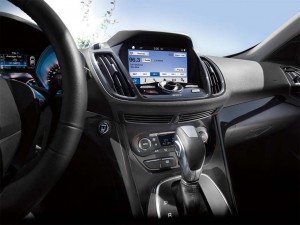In another sign of the strange bedfellow relationships reshaping the auto industry, Toyota is teaming up with Ford to develop an open-source version of Ford’s AppLink connected-car infotainment system.
The concept, which will be central to the completely updated Sync 3 infotainment system Ford will launch over the summer, is similar to the Apple CarPlay and Android Auto systems many automakers are planning to adapt. Toyota would apparently use it to update or replace its own Entune infotainment technology.
Where automakers long took price in doing their own R&D, they are increasingly turning either to outside suppliers or, in a growing number of instances, partnering with each other.
That’s most common when it comes to the development of costly and complex high-technology systems, whether infotainment or advanced alternative powertrains. Toyota and Ford are already sharing joint research on hydrogen fuel-cells.
(For more on the launch of the new Ford Sync 3, Click Here.)
When it comes to connected cars, one of the hottest topics is app integration that can let a driver access features such as a smartphone navigation system, an audio service such as Pandora or Spotify, and even texting and e-mail apps which can then be operated through a vehicle’s voice controls.
“We continue to investigate new technologies that both enhance and safeguard the driving experience of Toyota and Lexus owners,” said Shigeki Terashi, Senior Managing Officer, Toyota Motor Corporation. “The in-car app market is quickly evolving. Developing robust, flexible, safe and user-friendly connected services is a priority for us, and one that we believe is shared by Ford, Livio and other contributors to SDL technology.”
SDL is the technical term for the SmartDevice Link, or SDL, platform behind Ford’s AppLink. Its development has been overseen by Livio. That suburban Detroit company began as a maker of in-home Internet radios before shifting to app integration. It was then acquired by Ford to help improve the Sync system.
Ford will launch Sync 3, with the enhanced AppLink, on two U.S. models this summer, the 2016 Fiesta compact line and the Escape SUV. It will expand to the entire American line-up in short order. Ford also says it eventually plans to make its products compatible with CarPlay and Android Auto by the end of next year. Chevrolet recently said it will add both systems to 14 models next year. And app integration is expected to quickly become ubiquitous from top to bottom in the auto industry.
(Chevy adding Android Auto, Apple CarPlay to 14 different models for 2016. Click Here for more.)
Exactly how AppLink will integrate with those two systems is unclear. Together, Toyota and Ford will develop an open-source version of AppLink. Google’s Android operating system is an example of its approach. The basic OS is then modified by various smartphone manufacturers, such as Samsung, to meet their particular needs.
“At Ford, we view all aspects of time behind the wheel as core to the experience we provide customers,” said Ford connected vehicles director Don Butler. “We’re please other members of the industry feel the same way, and look forward to working together to drive even more support for the SDL developer community.”
Neither Toyota nor Ford has laid out a timeline for the project, though the pressure to get the latest and greatest infotainment system on the road is intense.
Ford launched its Sync system in 2007 and claims to currently have 12 million vehicles on the road using it. Toyota actually got into the in-car technology market with a separate joint venture, a brief alliance with General Motors’ OnStar telematics unit, before launching Entune in 2011 on the 2012 model-year Prius V.
(Ford, Microsoft team back up on new project. Click Here to learn what it’s about.)

